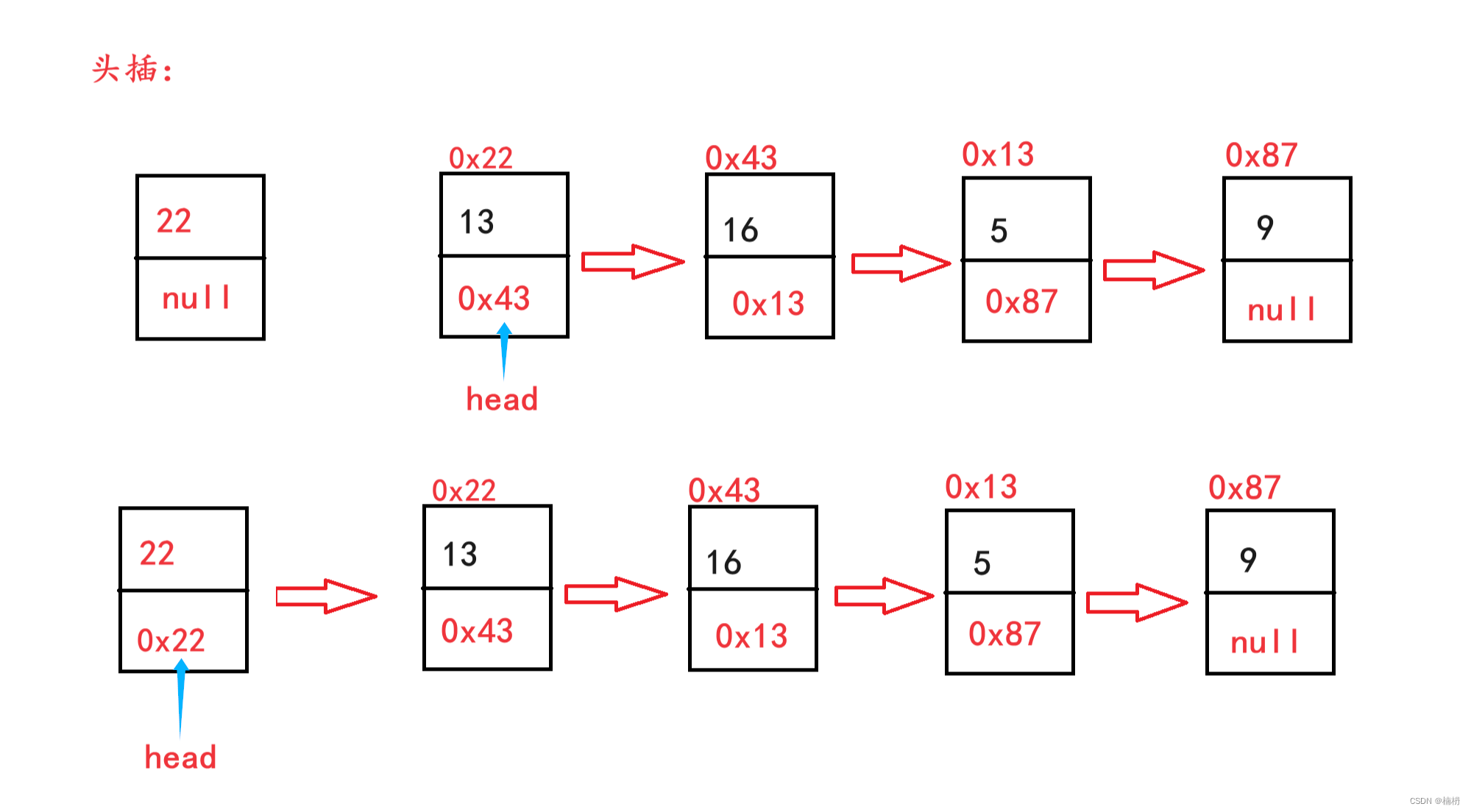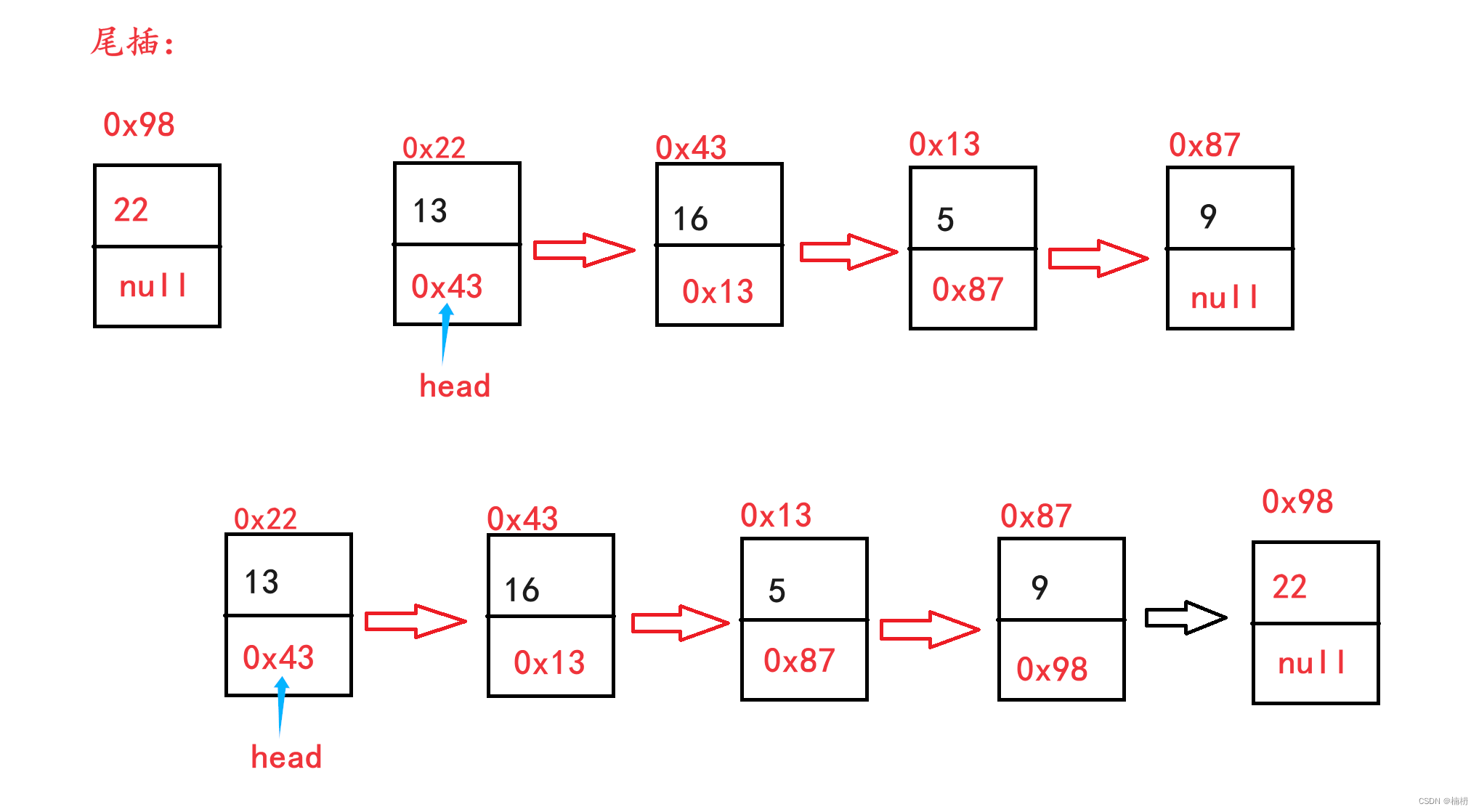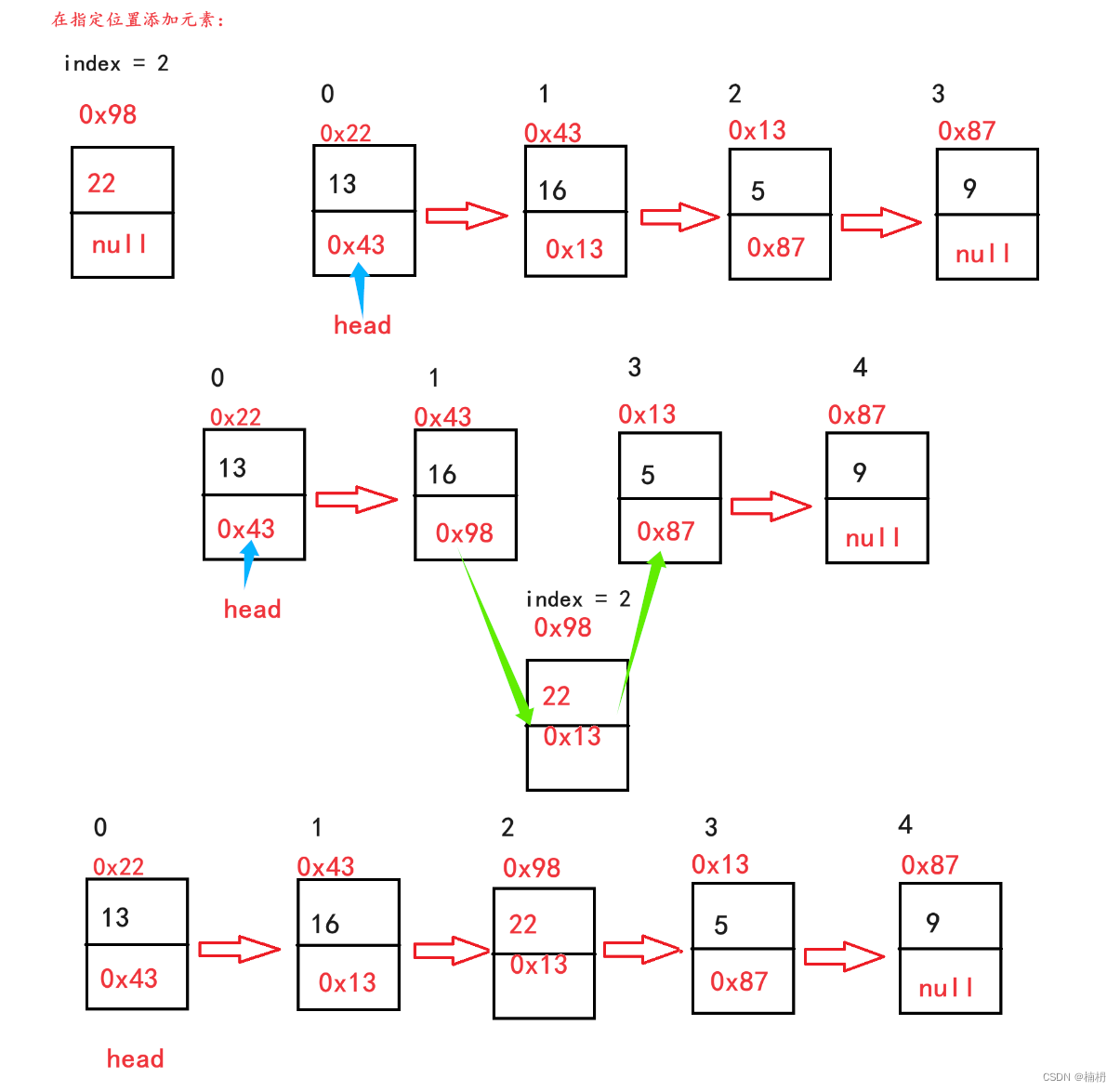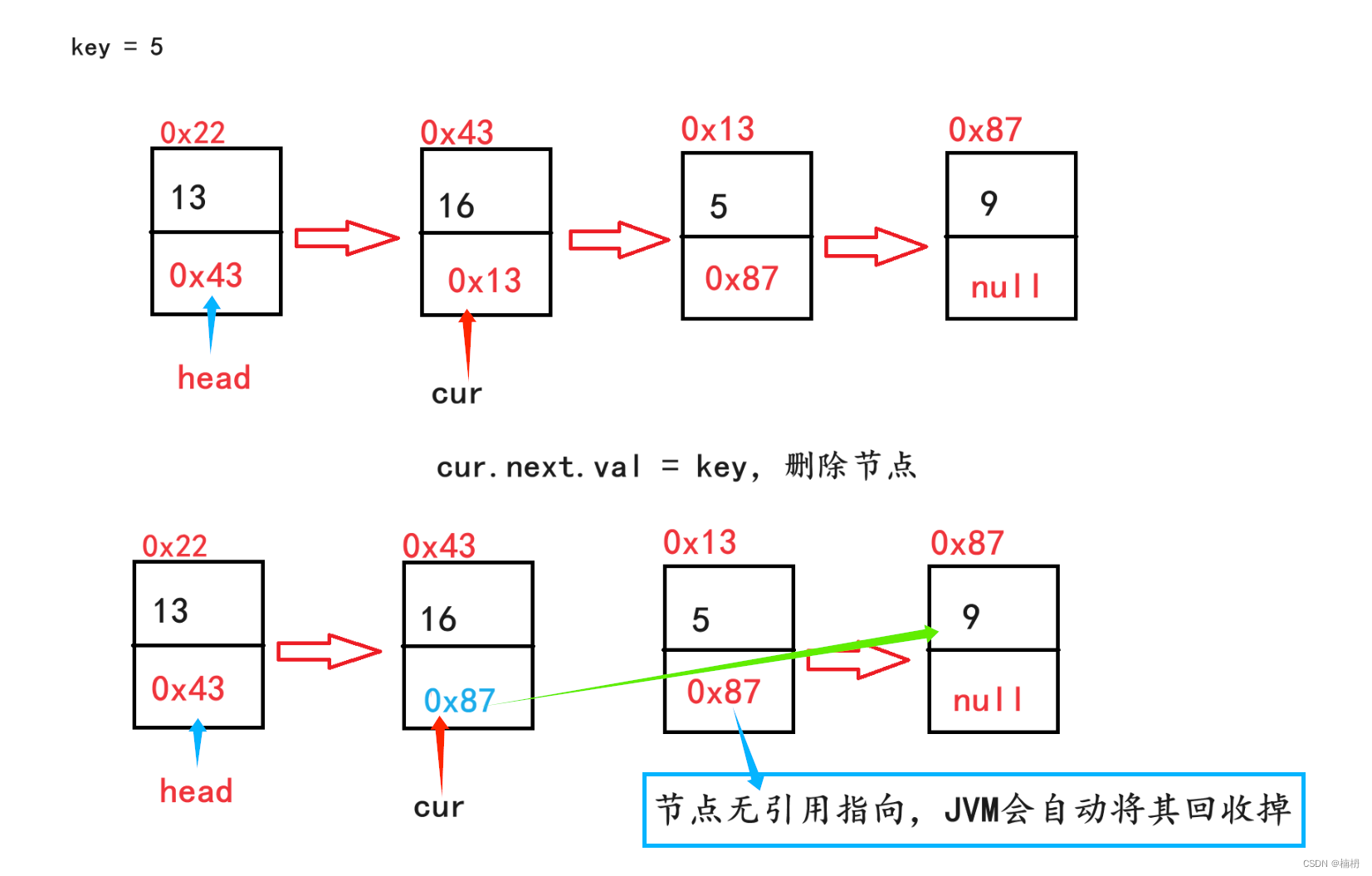目录
一.单链表
二.单链表基本操作的实现
1.单链表类、属性的定义
2.求链表长度
3.链表是否包含值为key的节点
4.添加元素
5.删除节点
6.清空链表
三、完整代码
一.单链表
链表是一种在物理存储结构上非连续的存储结构,数据元素的逻辑顺序通过链表中的引用链接次序实现。链表的结构多样,我们通过实现无头单向非循环链表,来进一步理解链表。

从图中可以看出,链表在逻辑上是连续的,但在物理存储结构上不一定是连续的
由于链表是单向的,可以通过前一个节点访问后一个节点,不能通过后一个节点访问前一个结点
二.单链表基本操作的实现
1.单链表类、属性的定义
要创建链表首先要有节点,我们可以将节点定义为内部类
public class MySingleList{
static class ListNode{
//存放当前结点的值
private int val;
//存放下一节点的地址
private ListNode next;
public ListNode(){}
public ListNode(int val){
this.val = val;
}
}
}由于链表是通过前一个节点访问下一个节点的,因此我们需要知道链表的第一个节点,因此我们需要定义一个头节点
private ListNode head;//第一个节点
2.求链表长度
定义变量count用以计算,遍历链表,统计链表节点个数
//求链表长度
public int size() {
int count = 0;
//定义节点cur,用于遍历链表
ListNode cur = head;
while(cur != null){
count++;
//指向下一节点
cur = cur.next;
}
return count;
}3.链表是否包含值为key的节点
遍历链表,判断节点的值是否等于key
public boolean contains(int key) {
ListNode cur = head;
while(cur != null){
if(cur.val == key){
return true;
}
cur = cur.next;
}
return false;
}4.添加元素
链表添加元素的方式通常有三种,头插、尾插和在指定位置添加元素。
头插:在链表的第一个节点前插入元素

实现头插,就是让要插入的节点node指向原本链表的头节点head,再更新链表的第一个节点,让head指向新插入的节点
//头插
public void addFirst(int data) {
//创建新节点
ListNode listNode = new ListNode(data);
listNode.next = head;
head = listNode;
}尾插:在链表的最后插入元素

实现尾插,首先要找到链表的最后一个节点,再将最后一个节点的next更新为新节点即可
//尾插
public void addLast(int data) {
ListNode newNode = new ListNode(data);
//若链表为空,直接将head更新为插入节点
if(head == null){
head = newNode;
}else{
//通过遍历找到最后一个节点
ListNode cur = head;
while(cur.next != null){
cur = cur.next;
}
cur.next = newNode;
}
}在指定位置添加元素

在指定位置添加元素,首先要判断指定位置index是否合法,若index < 0 或 index > size,则不能添加元素,然后通过遍历找到节点插入的位置,由于链表为单链表,不能通过后一节点找到前一节点,因此,我们需要找到插入位置的前驱节点,然后通过前驱节点实现链表在index位置的插入
//在任意位置添加元素
public void addIndex(int index, int data) {
//index不正确,无法添加元素
if(index < 0 || index > size()){
throw new RuntimeException("输入位置不正确,无法添加元素!");
}else if(index == 0){//在0位置插入,即为头插
addFirst(data);
}else{
ListNode cur = head;//用cur遍历链表,找到前驱节点
ListNode listNode = new ListNode(data);
int count = 0;
while(count != index-1){
count++;
cur = cur.next;
}
//添加元素
listNode.next = cur.next;
cur.next = listNode;
}
}5.删除节点

删除第一个值为key的节点:与在指定位置添加元素相同,我们需要找到第一个值为key的节点node的前驱节点,然后才能删除值为key的节点。由于JVM会将未被任何引用指向的对象回收掉,我们只需让node的前驱节点指向node的下一节点,即可实现删除
//删除第一个值为key的节点
public boolean remove(int key) {
ListNode cur = head;
//链表第一个节点的值即为key,头删
if(head.val == key){
head = head.next;
return true;
}//通过遍历找到第一个值为key的节点的前驱节点
while(cur.next != null){
if(cur.next.val == key){//找到了,删除节点
cur.next = cur.next.next;
return true;
}
cur = cur.next;
}
return false;//未找到值未key的节点,返回false
}删除所有值为key的节点:首先要找到值为key的节点node,将node的上一节点指向node的下一节点,即可删除值为key的节点,注意考虑头节点值为key的情况,要删除链表中所有值为key的节点,利用while循环即可实现。
//删除所有值为key的节点
public void removeAllKey(int key) {
//若链表为空,则直接返回null
if(head == null){
return;
}
ListNode cur = head;
while(cur.next != null){
if(cur.next.val == key){
cur.next = cur.next.next;
}else{
cur = cur.next;
}
}
//单独考虑头节点的值是否等于val
if(head.val == key){
head = head.next;
}
}6.清空链表
由于JVM会将未被任何引用指向的对象回收掉,清空链表可以将每个节点的指向都置为null,即切断节点之间的链接,也可以直接将head置为null
将每个节点的指向都置为null文章来源:https://uudwc.com/A/dbxnx
//清空链表
public void clear() {
if(head == null){//链表本身为空
return;
}
ListNode cur = head;
while(cur != null){
ListNode next = cur.next;//记录下一节点
cur.next = null;
cur = next;
}
}直接将head置为null文章来源地址https://uudwc.com/A/dbxnx
//清空链表
public void clear() {
head = null;
}
三、完整代码
public class MySingleList {
static class ListNode{
//存放当前结点的值
private int val;
//存放下一节点的地址
private ListNode next;
public ListNode(){}
public ListNode(int val){
this.val = val;
}
}
private ListNode head;//第一个节点
//求链表长度
public int size() {
int count = 0;
//定义节点cur,用于遍历链表
ListNode cur = head;
while(cur != null){
count++;
//指向下一节点
cur = cur.next;
}
return count;
}
//链表是否包含值为key的节点
public boolean contains(int key) {
ListNode cur = head;
while(cur != null){
if(cur.val == key){
return true;
}
cur = cur.next;
}
return false;
}
//头插
public void addFirst(int data) {
//创建新节点
ListNode listNode = new ListNode(data);
listNode.next = head;
head = listNode;
}
//尾插
public void addLast(int data) {
ListNode newNode = new ListNode(data);
//若链表为空,直接将head更新为插入节点
if(head == null){
head = newNode;
}else{
//通过遍历找到最后一个节点
ListNode cur = head;
while(cur.next != null){
cur = cur.next;
}
cur.next = newNode;
}
}
//在任意位置添加元素
public void addIndex(int index, int data) {
//index不正确,无法添加元素
if(index < 0 || index > size()){
throw new RuntimeException("输入位置不正确,无法添加元素!");
}else if(index == 0){//在0位置插入,即为头插
addFirst(data);
}else{
ListNode cur = head;//用cur遍历链表,找到前驱节点
ListNode listNode = new ListNode(data);
int count = 0;
while(count != index-1){
count++;
cur = cur.next;
}
//添加元素
listNode.next = cur.next;
cur.next = listNode;
}
}
//删除第一个值为key的节点
public boolean remove(int key) {
ListNode cur = head;
//链表第一个节点的值即为key,头删
if(head.val == key){
head = head.next;
return true;
}//通过遍历找到第一个值为key的节点的前驱节点
while(cur.next != null){
if(cur.next.val == key){//找到了,删除节点
cur.next = cur.next.next;
return true;
}
cur = cur.next;
}
return false;//未找到值未key的节点,返回false
}
//删除所有值为key的节点
public void removeAllKey(int key) {
//若链表为空,则直接返回null
if(head == null){
return;
}
ListNode cur = head;
while(cur.next != null){
if(cur.next.val == key){
cur.next = cur.next.next;
}else{
cur = cur.next;
}
}
//单独考虑头节点的值是否等于val
if(head.val == key){
head = head.next;
}
}
//清空链表
public void clear() {
if(head == null){//链表本身为空
return;
}
ListNode cur = head;
while(cur != null){
ListNode next = cur.next;//记录下一节点
cur.next = null;
cur = next;
}
//或直接将head置为null
//head = null;
}
}

